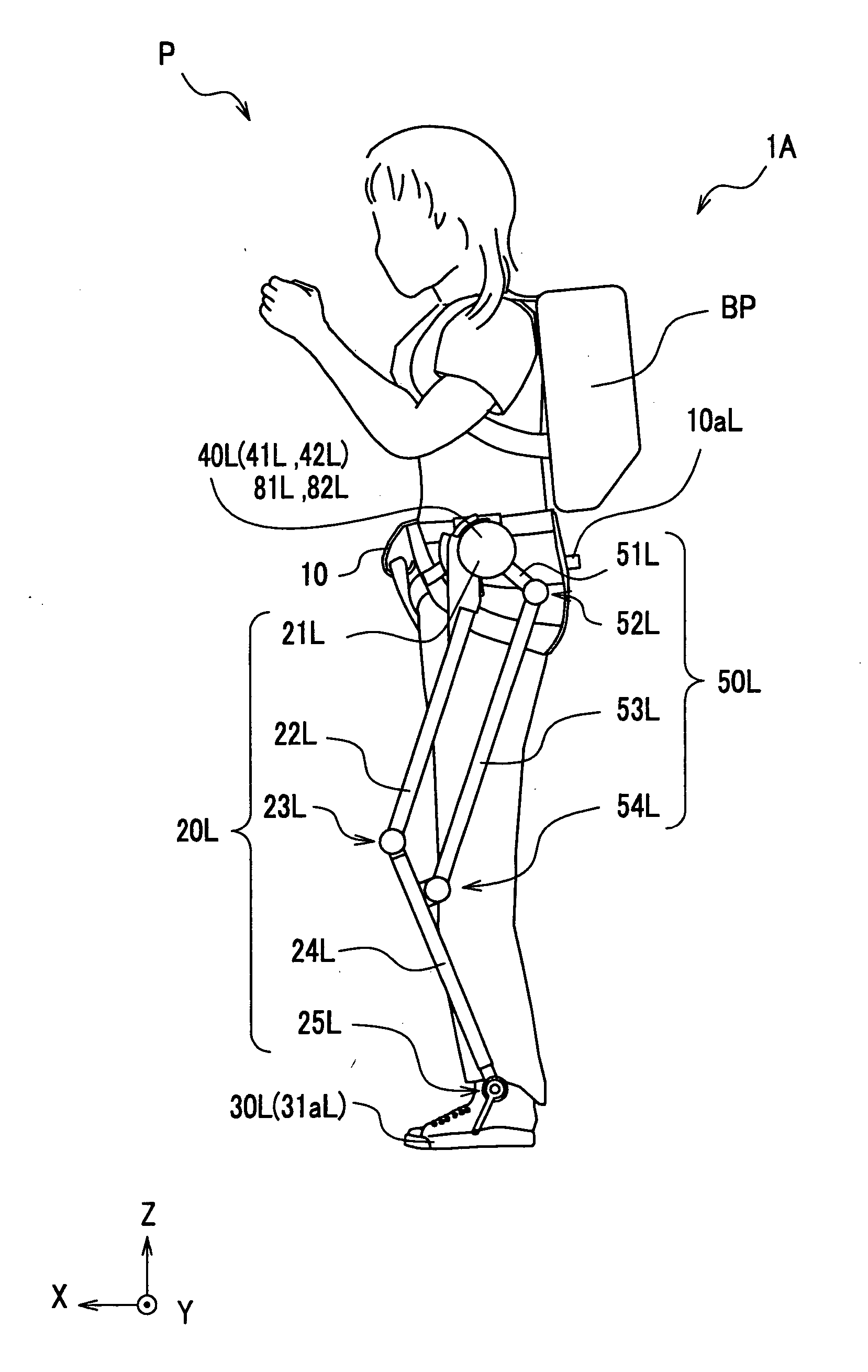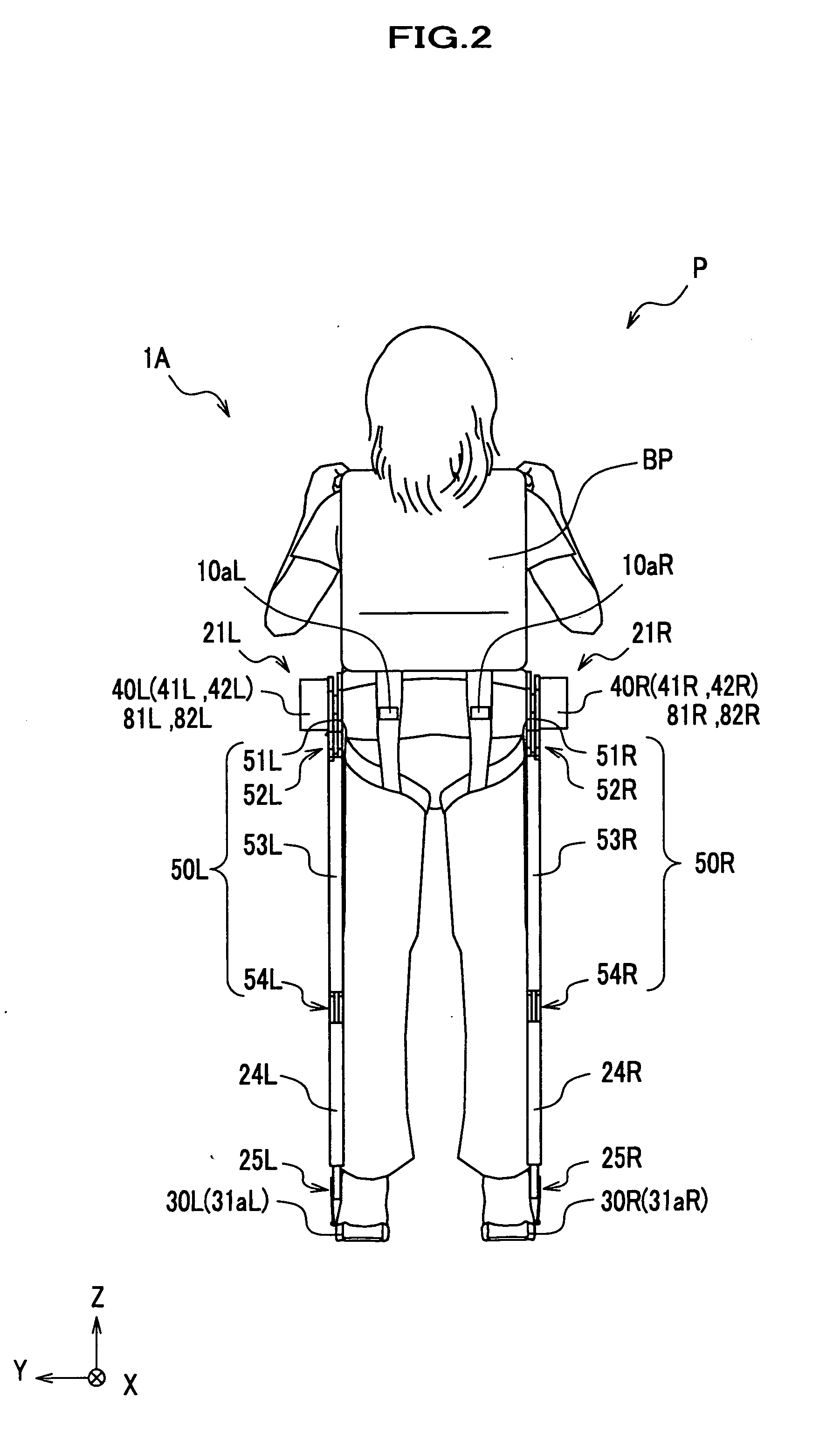Apparatus for assisting limb and computer program
a technology for assisting limbs and computers, applied in the field of apparatus for assisting limbs and computer programs, can solve the problems of large size, difficult to carry out synchronous control, and large inertial moment of lower limb movement, so as to reduce the load imposed on users, not only the load, but the load
- Summary
- Abstract
- Description
- Claims
- Application Information
AI Technical Summary
Benefits of technology
Problems solved by technology
Method used
Image
Examples
first embodiment
I. First Embodiment
[0066] Description is given of an apparatus for assisting limb according to a first embodiment of the present invention. In FIG. 7 an ankle joint unit is not shown. FIG. 1 to FIG. 4 illustrate a user P who wears an apparatus 1A for assisting limb. For convenience of explanation, wires connecting actuators, sensors, controllers and batteries are not shown.
[0067] As shown in FIG. 1 to FIG. 4, the apparatus 1A for assisting limb (also referred to as “apparatus for assisting lower limb”) includes a body attachment 10, links for lower limb 20L and 20R, foot attachments 30L and 30R, actuator units 40L and 40R, drive units 50L and 50R and a back pack BP.
a. Body Attachment 10
[0068] As shown in FIG. 1 to FIG. 4, the body attachment 10 (also referred to as “body trunk attachment”) is attached to a trunk of the user P.
[0069] As shown in FIG. 5, the body attachment 10 includes a waist belt 11, upper leg belts 12L and 12R, actuator mounting members 13L and 13R, reinforceme...
second embodiment
II. Second Embodiment
[0231] Description is given of an apparatus for assisting limb according to a second embodiment of the present invention, focusing on differences with respect to an apparatus 1A for assisting limb according to the first embodiment. In the following drawings which are referred to in description of embodiments, only relevant portions are schematically described, which are necessary for making a comparison with the apparatus 1A according to the first embodiment. In FIGS. 19-21, for example, a hip joint actuator 41R is omitted.
[0232] In FIGS. 19 to 22, because left and right components are identical in architecture, symbols are only given to the right components, omitting those for the left ones.
[0233] As shown in FIG. 19, an apparatus 1B for assisting limb according to the second embodiment of the present invention has a drive unit 150R instead of a drive unit 50R.
[0234] The drive unit 150R has a first pulley 151R, a second pulley 152R and an endless belt 153R. ...
third embodiment
III. Third Embodiment
[0236] Description is given of an apparatus for assisting limb according to a third embodiment of the present invention, focusing on differences with respect to an apparatus 1A for assisting limb according to the first embodiment.
[0237] As shown in FIG. 20, an apparatus 1C according to the third embodiment has not only a knee joint actuator 242R instead of a knee joint actuator 42R, but also a drive unit 250R instead of a drive unit 50R.
[0238] The drive unit 250R has a wire mounting member 251R, a knee joint actuator 242R and two wires 252R and 253R. The wire mounting member 251R, which is integrally coupled with a link for lower leg 24R, is located in an outer portion of a knee joint unit 23R. The two wires 252R and 253R are routed between the wire mounting member 251R and the knee joint actuator 242R.
[0239] The knee joint actuator 242R drives the knee joint unit 23R by pulling the wire 252R and loosening the wire 253R, or vice versa.
PUM
 Login to View More
Login to View More Abstract
Description
Claims
Application Information
 Login to View More
Login to View More - R&D
- Intellectual Property
- Life Sciences
- Materials
- Tech Scout
- Unparalleled Data Quality
- Higher Quality Content
- 60% Fewer Hallucinations
Browse by: Latest US Patents, China's latest patents, Technical Efficacy Thesaurus, Application Domain, Technology Topic, Popular Technical Reports.
© 2025 PatSnap. All rights reserved.Legal|Privacy policy|Modern Slavery Act Transparency Statement|Sitemap|About US| Contact US: help@patsnap.com



